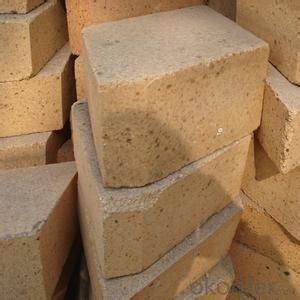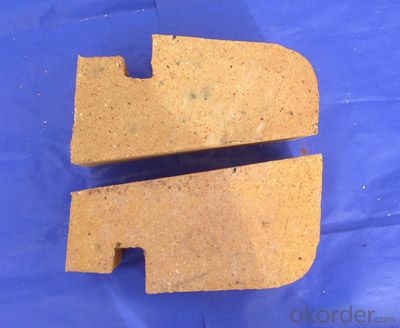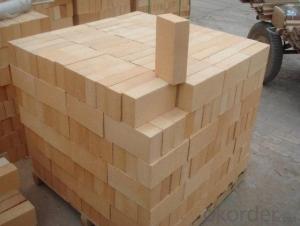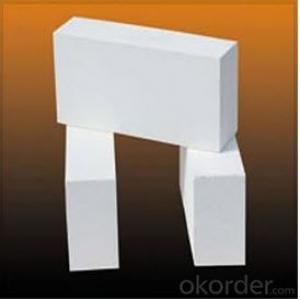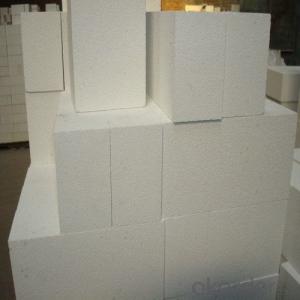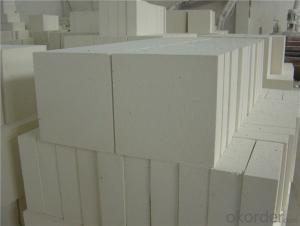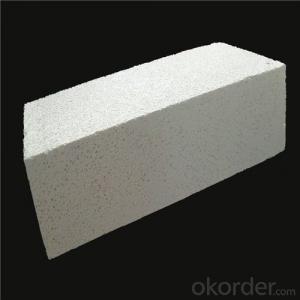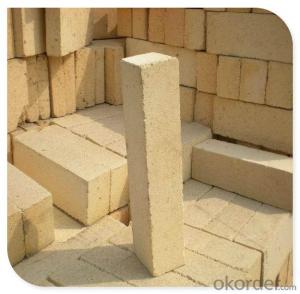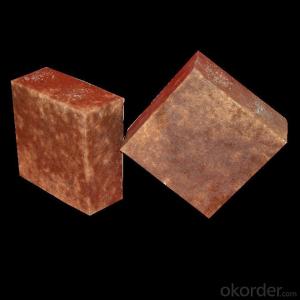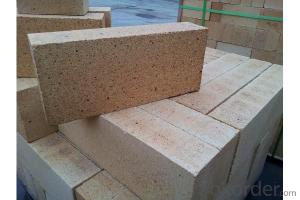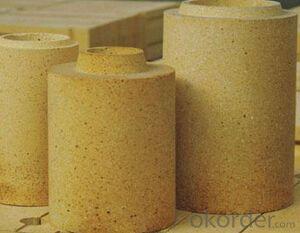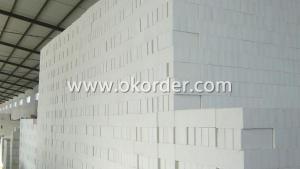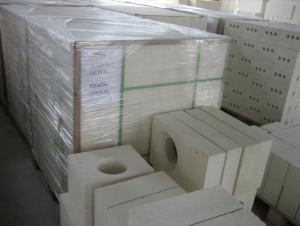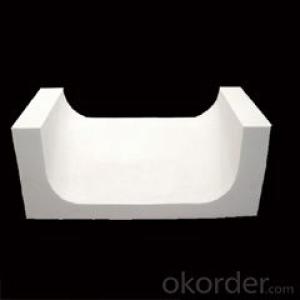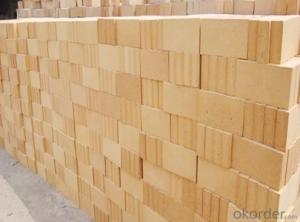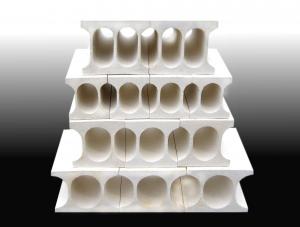Insulating Fire Brick for Hot Blast Stove Refractory Applications
- Loading Port:
- China Main Port
- Payment Terms:
- TT OR LC
- Min Order Qty:
- -
- Supply Capability:
- -
OKorder Service Pledge
OKorder Financial Service
You Might Also Like
Specifications
Fire brick1.ISO 9001 approved,
2.With high quality and competitive price,
3.Standard and special shape.
Fire-clay refractory brick.
1. N-1
AL2O3 (%)>42
Refractoriness >1750
Refractoriness under load KD>1400
Permanent linear change onreheating
1500*2h
1450*2h
1400*2h:+0.1; -0.4
Apparent Porosity(%)<22
Cold crushing strength (Mpa)>29.4
2. N-2a
AL2O3 (%)>40
Refractoriness >1730
Refractoriness under load KD>1350
Permanent linear change onreheating
1500*2h
1450*2h
1400*2h:+0.1; -0.5
Apparent Porosity(%)<24
Cold crushing strength (Mpa)>24.5
High-alumina refractory brick
1. LZ-75
AL2O3 (%)>75
Refractoriness>1790
Refractoriness under load KD>1520
Permanent linear change onreheating
1500*2h:+0.1; -0.4
1450*2h
1400*2h
Apparent Porosity(%)<23
Cold crushing strength (Mpa)>53.9
2. LZ-65
AL2O3 (%)>65
Refractoriness >1790
Refractoriness under load KD>1500
Permanent linear change onreheating
1500*2h:+0.1; -0.4
1450*2h
1400*2h
Apparent Porosity(%)<23
Cold crushing strength (Mpa)>49
3.LZ-55
AL2O3 (%)>55
Refractoriness >1770
Refractoriness under load KD>1470
Permanent linear change onreheating
1500*2h:+0.1; -0.4
1450*2h
1400*2h
Apparent Porosity(%)<22
Cold crushing strength (Mpa)>44.1
4.LZ-48
AL2O3 (%)>48
Refractoriness >1750
Refractoriness under load KD>1420
Permanent linear change onreheating
1500*2h
1450*2h:+0.1; -0.4
1400*2h
Apparent Porosity(%)<22
Cold crushing strength (Mpa)>39.2
Fire clay brick SK-32 | |
Item | Standard |
AI2O3(%) | 30 |
Fe2O3 (%) | 3.5 |
Refractoriness (SK) | 32 |
Refractoriness under load, 0.2MPa, Ta, (°C) | 1300 |
Porosity (%) | 22-26 |
Bulk density (g/cm³) | 2.05 |
Cold crushing strength (MPa) | 25 |
Thermal expansion at 1000°C (%) | 0.6 |
Fire clay brick SK-34 | |
Item | Standard |
AI2O3(%) | 38 |
Fe2O3 (%) | 2.5 |
Refractoriness (SK) | 34 |
Refractoriness under load, 0.2MPa, Ta, (°C) | 1350 |
Porosity (%) | 19-23 |
Bulk density (g/cm³) | 2.10-2.15 |
Cold crushing strength (MPa) | 25 |
Thermal expansion at 1000°C (%) | 0.6 |
Fire clay brick SK-36 | |
Item | Standard |
AI2O3(%) | 50 |
Fe2O3 (%) | 2 |
Refractoriness (SK) | 36 |
Refractoriness under load, 0.2MPa, Ta, (°C) | 1450 |
Porosity (%) | 20-24 |
Bulk density (g/cm³) | 2.30-2.40 |
Cold crushing strength (MPa) | 45 |
Thermal expansion at 1000°C (%) | 0.3 |
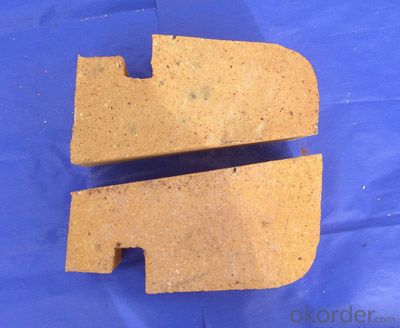
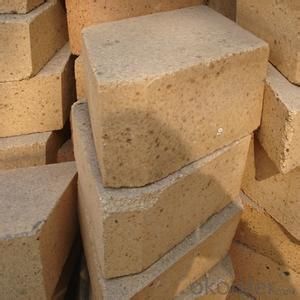
- Q: Can insulating fire bricks be used as a lining for boilers?
- Indeed, boilers can make use of insulating fire bricks as linings. These bricks are specifically engineered to endure extreme temperatures and possess outstanding thermal insulation capabilities. Their prevalent application lies in contexts where conserving heat and promoting energy efficiency are paramount, notably in industrial boiler settings. The insulating properties inherent in these bricks facilitate the reduction of heat dissipation and enhance the overall efficiency of the boiler. Furthermore, their robustness and ability to withstand thermal shock render them fitting for deployment within boiler linings, where they can endure the harshest conditions and temperature fluctuations.
- Q: Can insulating fire bricks be used for insulation in cold storage facilities?
- Yes, insulating fire bricks can be used for insulation in cold storage facilities. Insulating fire bricks are made from lightweight materials with high insulating properties, such as ceramic or refractory fibers. They have low thermal conductivity, which means they can effectively prevent heat transfer and maintain a stable temperature inside the cold storage facility. The bricks are also resistant to extreme cold temperatures and can withstand thermal shock, making them suitable for use in cold storage applications. Additionally, insulating fire bricks are durable and can provide long-term insulation, reducing energy consumption and maintaining the desired temperature for storing perishable goods.
- Q: Can insulating fire bricks be used in the construction of radiant tubes?
- Yes, insulating fire bricks can be used in the construction of radiant tubes. These bricks are designed to have low thermal conductivity, which makes them an excellent choice for insulating applications such as radiant tubes. They can help to minimize heat loss and improve the efficiency of the radiant heating system.
- Q: Can insulating fire bricks be used in the construction of heat storage units?
- Indeed, the utilization of insulating fire bricks is viable in the construction of heat storage units. These bricks are specifically engineered to endure extreme temperatures and possess exceptional thermal insulation properties. They are commonly employed in scenarios where heat retention holds significance, such as furnaces, kilns, and heat storage units. With their low thermal conductivity, these bricks effectively retain and preserve heat for extended durations, rendering them an ideal choice for heat storage units designed to capture and store heat energy for later usage. Additionally, these bricks are lightweight and easy to manipulate, making them a practical selection for construction projects. All in all, incorporating insulating fire bricks into the construction of heat storage units is a suitable and dependable option.
- Q: Can insulating fire bricks be used in chimneys and flues?
- Insulating fire bricks are specifically designed for high-temperature applications and are often used in furnaces, kilns, and other industrial settings. While they do possess excellent insulating properties, they may not be the best choice for chimneys and flues in residential or commercial buildings. The main reason for this is that insulating fire bricks are not as durable and heat-resistant as other materials specifically designed for chimney and flue construction. They may crack or break when exposed to the extreme heat and rapid temperature changes that occur in chimneys. Additionally, these bricks are not typically designed to withstand the corrosive effects of flue gases, which can lead to their degradation over time. When it comes to chimneys and flues, it is generally recommended to use materials such as clay flue liners, stainless steel, or refractory bricks that are specifically manufactured for these applications. These materials are better suited to handle the high temperatures, corrosive gases, and rapid thermal expansion and contraction that occur in chimneys. It is important to consult with a professional chimney or flue specialist who can advise on the appropriate materials to use based on the specific requirements and conditions of your chimney or flue system.
- Q: What is the typical lifespan of an insulating fire brick?
- The typical lifespan of an insulating fire brick can vary depending on various factors such as the quality of the brick, the temperature it is exposed to, and the frequency of thermal cycling. However, on average, insulating fire bricks can last anywhere from 5 to 20 years.
- Q: How do insulating fire bricks affect the overall durability of a structure?
- Insulating fire bricks play a crucial role in enhancing the overall durability of a structure. These bricks are designed to have a low thermal conductivity, which means they are effective in resisting heat transfer. By reducing the amount of heat that passes through the bricks, they help to maintain a stable temperature within the structure, protecting it from extreme temperature variations. One of the key benefits of insulating fire bricks is their ability to withstand high temperatures. They have a high melting point, which allows them to retain their structural integrity even in the presence of intense heat. This quality is particularly important in structures where high temperatures are generated, such as furnaces or kilns. The ability of insulating fire bricks to handle such extreme temperatures greatly contributes to the durability of the structure. Furthermore, insulating fire bricks offer excellent insulation properties. Their low thermal conductivity prevents heat from escaping or entering the structure, leading to energy efficiency. This not only reduces energy consumption but also protects the structure from potential damage caused by excessive heat loss. By maintaining a consistent temperature, insulating fire bricks prevent thermal expansion and contraction, which can lead to cracks and structural instability. In addition to their heat resistance and insulation properties, insulating fire bricks are also known for their resistance to chemical corrosion. Many structures are exposed to harsh environments or chemicals that can cause degradation. However, insulating fire bricks are made from materials that are resistant to chemical reactions, ensuring their durability and longevity. Overall, the use of insulating fire bricks significantly enhances the durability of a structure. Their ability to withstand high temperatures, provide insulation, and resist chemical corrosion make them a valuable component in various industrial and residential applications. By ensuring a stable and protected environment, insulating fire bricks contribute to the long-lasting and reliable performance of the structure.
- Q: Can insulating fire bricks be used in aluminum smelting furnaces?
- Indeed, it is possible to utilize insulating fire bricks within aluminum smelting furnaces. The purpose of these bricks is to possess a low thermal conductivity, thus reducing heat losses within the furnace. This characteristic renders them suitable for various high-temperature applications, including aluminum smelting. Additionally, insulating fire bricks exhibit exceptional resistance to thermal shock, enabling them to endure sudden temperature fluctuations that frequently occur during the smelting process. Moreover, their lightweight nature facilitates ease of handling and installation within the furnace. All in all, insulating fire bricks serve as a practical choice for aluminum smelting furnaces, contributing to enhanced energy efficiency and reduced operational expenses.
- Q: Can insulating fire bricks be used in the construction of thermal storage units?
- Yes, insulating fire bricks can be used in the construction of thermal storage units. These bricks are designed to withstand high temperatures and provide excellent insulation, making them suitable for thermal storage applications where heat retention is crucial.
- Q: Are insulating fire bricks suitable for use in carbon black furnaces?
- Yes, insulating fire bricks are suitable for use in carbon black furnaces. These bricks are known for their high insulation properties, which help in maintaining high temperatures inside the furnace while preventing heat loss. Additionally, insulating fire bricks are designed to withstand extreme temperatures and chemical reactions, making them a suitable choice for carbon black furnaces that operate under high heat and harsh conditions.
Send your message to us
Insulating Fire Brick for Hot Blast Stove Refractory Applications
- Loading Port:
- China Main Port
- Payment Terms:
- TT OR LC
- Min Order Qty:
- -
- Supply Capability:
- -
OKorder Service Pledge
OKorder Financial Service
Similar products
Hot products
Hot Searches
Related keywords



